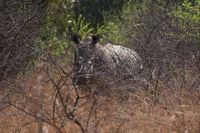On Monday, September 22, 2025, South Africa marked World Rhino Day—a global event that brings attention to the ongoing struggle to save one of the planet’s most iconic and endangered animals. For conservationists across the country, the day was both a celebration of progress and a sobering reminder of the challenges that remain. Despite decades of relentless work, South Africa still loses, on average, one rhino every single day to poachers. The fight, it seems, is far from over.
South Africa is home to the world’s largest populations of both black and southern white rhinos, holding a pivotal role in the fate of these species. According to the Associated Press, the country currently shelters more than 2,000 of the 6,700 black rhinos left in the wild or in reserves, as well as between 12,000 and 13,000 of the world’s 15,000 remaining southern white rhinos. These two species, found only in Africa, stand as living testaments to both the success and the fragility of modern conservation.
The Dinokeng Game Reserve, located just north of Pretoria, is one of South Africa’s success stories. Its rhino population is thriving, but the exact numbers and details of the security measures in place are closely guarded secrets. As the AP reports, this secrecy is a necessary protocol—reserves with rhinos must protect their animals not just from poachers, but from information leaks that could make them targets. "It would be naive to think that poaching is not a threat even though we haven’t had incidents in many years," said Marius Fuls, a wildlife monitor and ranger at Dinokeng. "Poaching is always a threat."
For years, South Africa has been the epicenter of rhino poaching, a crisis deeply linked to organized crime networks. Rhino horn, prized in some Asian markets for supposed medicinal properties and as a status symbol, can fetch prices higher than gold on the black market. The stakes are high, and so is the cost of protection. Yet, there has been progress. Thanks to collaboration between government-run parks and private reserves like Dinokeng, the number of rhinos killed annually by poachers has dropped dramatically—from well over 1,000 a decade ago to 420 last year. Still, the South African Environment Ministry reported that 195 rhinos were killed in the first half of 2025 alone, maintaining the grim average of one rhino lost per day.
Conservationists refuse to give up hope. "Please do not tell a ranger that we’re not going to win this war," Fuls emphasized. "If we as conservationists stop believing that we’re going to win this, then we have lost it. We’re the last thin green line between the extinction of rhinos." That determination is visible in the evolving arsenal of anti-poaching tactics deployed across South Africa. According to the AP, rangers now use drones, night surveillance equipment, radar technology, motion-sensing cameras, and artificial intelligence to monitor vast reserves. Rhinos are fitted with tracking devices, allowing rangers to know their precise locations at all times. K-9 dog units patrol alongside their human counterparts, sniffing out threats before they can strike.
Some reserves have taken the controversial step of dehorning their rhinos—a process that removes the horn to make the animals less attractive targets for poachers. While this doesn’t entirely eliminate the risk, it is one of several creative strategies conservationists are using to tip the scales in favor of the rhinos.
Innovation continues on other fronts as well. In 2025, a group of South African scientists, working with the International Atomic Energy Agency, launched a program to inject small amounts of radioactive material into rhino horns. The idea is twofold: to make the horns unsellable on illegal markets and to ensure that any horn smuggled across borders can be easily detected. The scientists are quick to note that the radioactive material does not harm the rhinos. It’s a bold move, one that reflects the urgency and ingenuity driving the conservation movement today.
But technology and tactics alone aren’t enough. Sometimes, the answer is to move the rhinos themselves. Conservationists have revived the legendary Operation Rhino, first launched in the 1960s, which saved the southern white rhino from the brink of extinction by relocating the last survivors to safer areas. Today, this strategy is being repeated, both in South Africa and beyond. One notable effort, led by the Peace Parks Foundation, has seen nearly 50 black and white rhinos moved to Zinave National Park in neighboring Mozambique—a reserve once decimated by poaching. According to Peace Parks, the operation has already yielded results: eight rhino calves have been born in Zinave since the relocation. "It's been an incredible success story," said Gillian Rhodes, combating wildlife crime program manager at Peace Parks Foundation. Still, Rhodes cautioned that rhino poaching rates remain “devastating.”
World Rhino Day itself is a relatively recent creation, established in 2010 to raise awareness about the threats facing all five of the world’s rhino species. While the focus often falls on Africa’s black and southern white rhinos, the situation in Asia is, if anything, even more dire. The International Rhino Foundation’s latest count puts the number of greater one-horned rhinos at just over 4,000. The Javan rhino population hovers around 50, while fewer than 50 Sumatran rhinos remain. These numbers are a stark reminder that the fight to save rhinos is a global one and that every loss counts.
Back in South Africa, the mood on World Rhino Day was one of cautious optimism mixed with resolve. The country’s unique position as both custodian and epicenter of the rhino crisis means that its actions resonate far beyond its borders. As conservationists, scientists, and rangers gathered to mark the day, their message was clear: progress is possible, but the battle is not yet won. Every rhino saved is a step toward a future where these extraordinary creatures might once again thrive in the wild—safe from the threat of extinction, and from the poachers who still hunt them, one day at a time.





